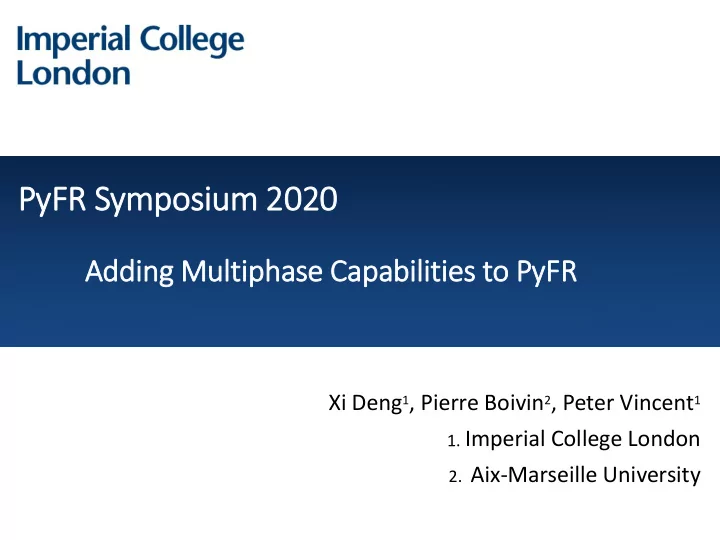

PyFR Symposium 2020 Addin ing Mult ltiphase Capabili lities to to PyF yFR Xi Deng 1 , Pierre Boivin 2 , Peter Vincent 1 1. Imperial College London 2. Aix-Marseille University
Contents 1. Research Background 2.Numerical Model for Reactive Multiphase Flow 3. Implementation on PyFR 2
Rese search Ba Background Advanced CFD Solver Advanced CFD solver should at least be able to solve multi-scale and multi-physics problems, and be compatible and scalable with modern computational hardware. Multi-scale in space: Discontinuous large scale: shock waves, shear layers, material interface Smooth small scale: turbulence, acoustic waves Multi-scale in time: Large scale: flow dynamics, Small scale: Detonation waves (explosion) Multi-physics processes: Multi-phases, combustion, phase-transition, fluid-structure interaction and so on 3
Rese search Ba Background PyFR PyFR is an open-source CFD solver, which is promising for solving multi- scale and multi-physics problems. Multi-scale Multi-domain Multi-physics Problems: Status of PyFR: Based on high order flux CPU, Nvidia GPU, AMD GPU Challenging for any high order reconstruction (FR), PyFR has CFD solver great advantage on scale- resolving simulation (DNS and LES) 4
Rese search Ba Background Multi-physics is challenging C. Le Touze , AMD , 2020 Challenging for models: Describe main physical processes without significantly increasing complexity Challenging for numerical method: More accurate and robust Firstly, we construct a reactive multi-phase model which can be integrated into PyFR 5
Numeri rical l Model l for r Reactiv ive Multip ltiphase Flo lows 1. . Governin ing Equatio ion Homogeneous Model Homogeneous assumption Advantages: This model can be solved as Navier-Stokes equations. Thus it can be solved using PyFR directly. Limitations: 1. Mixture pressure and temperature should be defined 2. Mechanical and thermo equilibrium assumption may not be true 6
Numeri rical l Model l for r Reactiv ive Multip ltiphase Flo lows 2.Thermodynamic ics Clo Closure NASG EOS By considering real fluid effects, the Noble-Abel Stiffened Gas (NASG) equation of state (EOS) with non-constant heat capacity for each component k : 7
Numeri rical l Model l for r Reactiv ive Multip ltiphase Flo lows 2. . Th Thermodynamic ics Clo Closure Simplified EOS based on assumptions 1. Only one component may be found in liquid form, which k =1. Its corresponding vapor has index k =2 2. The heat capacity is assumed to be a constant at low temperatures. 3. The liquid is assumed to be locally absent at high temperatures, where the gaseous heat capacity is no longer be constant. These assumptions are reasonable for most cryogenic jets under subcritical condition Thus the EOS with constant Cp for real fluid: The EOS with variable Cp for idea gas: 8
Numeri rical l Model l for r Reactiv ive Multip ltiphase Flo lows 2.Thermodynamic ics Clo Closure Hybrid thermodynamic closure We need to define the mixture P and T based on the mixture rules Mixture T for gas (with Newton Mixture T for liquid Mixture P for liquid Mixture P for gas solver ) 9
Numeri rical l Model l for r Reactiv ive Multip ltiphase Flo lows 3. . Phase Transit itio ion Modellin lling Fast relaxation model A. Chiapolino, P. Boivin, R. Saurel , C&F , 2017 Finite rate model: (expensive and complicated) Instead,we assume that relaxation to thermodynamic equilibrium is immediate Since total mass and energy are constant during phase transition: Using conservation law and thermochemical equilibrium condition: 10
Numeri rical l Model l for r Reactiv ive Multip ltiphase Flo lows 4. . Transport Model Simplified transport model Mixture rule for dynamic viscosity and thermal diffusion coefficient: For liquid phase, the µ and λ can be assumed to be constant and be independent of temperature, then for gas phase For diffusion velocity: where 11
Numeri rical l Model l for r Reactiv ive Multip ltiphase Flo lows 4. . Co Combustio ion Model Finite rate reaction model Considering a chemical system of N species involving M reactions as Then the source term is calculated as where progress rate is evaluated by 12
Numeri rical l Model l for r Reactiv ive Multip ltiphase Flo lows 6. . Vali lidatio ion th through numeric ical l tests Shock tube Evaporation is yielded with the shock compression and condensation is caused due to the rarefaction expansion wave 13
Numeri rical l Model l for r Reactiv ive Multip ltiphase Flo lows 6. . Vali lidatio ion th through numeric ical l tests Cavitation Bubble Cavitation bubble will be produced with decreased pressure caused by expansion waves 14
Numeri rical l Model l for r Reactiv ive Multip ltiphase Flo lows 6. . Vali lidatio ion th through numeric ical l tests Free propagating pre-mixed flame The 12-step skeletal mechanism for H2-O2 combustion Cantera reference (plain line), and the proposed numerical solver (red dashed line): 15
Numeri rical l Model l for r Reactiv ive Multip ltiphase Flo lows 6. . Vali lidatio ion th through numeric ical l tests Simulation of liquid oxygen and gaseous hydrogen rocket engine Before ignition 16
Numeri rical l Model l for r Reactiv ive Multip ltiphase Flo lows 6. . Vali lidatio ion th through numeric ical l tests Simulation of liquid oxygen and gaseous hydrogen rocket engine After ignition 17
Numeri rical l Model l for r Reactiv ive Multip ltiphase Flo lows Conclusion 1. A numerical model based on the homogeneous assumption for reactive multiphase has been constructed. 2. The model is composed of the hybrid thermodynamics closure, the fast phase transition relaxation solver and the combustion model with detailed chemistry. 3. The model is able to simulate complex multi-physics problems involving shock wave, moving material interface, phase transition and combustion. 4. Since this model is compatible for any solver for compressible NS equation, it can be integrated into PyFR directly. 18
Im Imple lementatio ion on PyFR Shock-bubble interaction Krypton Cp_kry=247.47 J/kg/k Cp_air=1003.5 J/kg/k 19
Thank you for your time and advices 20
Recommend
More recommend